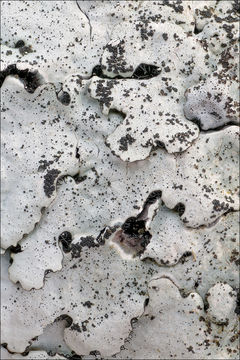Image of Parmelina pastillifera (Harm.) Hale

Description:
Slo.: ? - Syn.: Parmelia pastillifera (Harm.) R. Schub. & Klem., Parmelia tiliacea var. pastillifera (Harm.) Grummann - Habitat: tree hedge between abandoned pastures; moderately inclined mountain slope, south-east aspect; relatively warm and dry place; calcareous ground, sunny place; exposed to direct rain; average precipitations ~ 3.000 mm/year, average temperature 7-9 deg C, elevations 600 m (1.950 feet), alpine phytogeographical region. Substratum: bark of medium and small size branches of (almost) stand-alone, recently cut down Juglans regia. Comment: Parmelina pastillifera is a small to middle-size but beautiful and conspicuous lichen. Its rosettes 2-7(10) cm in diameter are characteristic by its light mineral-gray to whitish appearance with blue tint, appressed to substrate lobes with a thin, dark edge and few short cilia. Thallus underside is black (but lighter near the edge) with crowded, simple, black rhizines. The species loves precipitations. So, no wander it feels well in Trenta valley with its about 3.000 mm (120 inches) of rain per year. However, there exists another, more frequent species, Parmelina tiliacea, which is very similar to Parmelina pastillifera. It is practically impossible to distinguish both by habit only. In spite of this, they can be easily separated by observing their isidia (magnifying glass required). Both species have isidia when grown up. Parmelina pastillifera has black, button- or bun-shaped isidia, many of them are stalked. When they break off a small, white scar remains on the thallus surface (Ref.: 2) (see picture 7). On the other side Parmelina tiliacea has dark brown, cylindrical or coralloid isidia. Both species are rather rare and on the Red List at least in Germany (Ref.:5). In this observation many specimens were growing on branches (having 24 cm in diameter) of this tree. All of them were sterile (without apothecia), which is almost always the case. Ref.: (1) C.W. Smith, et al, The lichens of Great Britain and Ireland, The British Lichen Society, (2009), p 657. (2) V. Wirth, R. Dll, Farbatlas Flechten und Moose, Ulmer, (2000), p 74. (3) V. Wirth, Die Flechten Baden-Wrttembergs, Teil.2., Ulmer (1995), p 665. (4) F.S. Dobson, Lichens, The Richmonds Publishing Ca.LTD (2005), p 305. (5) B. Marbach, C. Kainz, Moose, Farne und Flechten, BLV (2002), p 74. (6) http://www.lichens.lastdragon.org/Parmelina_pastillifera.html (accessed Feb. 17. 2018)
Included On The Following Pages:
- Life (creatures)
- Cellular (cellular organisms)
- Eukaryota (eukaryotes)
- Opisthokonta (opisthokonts)
- Nucletmycea
- Fungi (mushrooms, lichens, molds, yeasts and relatives)
- Dikarya
- Ascomycota (sac fungi)
- Lecanoromycetes
- Lecanorales
- Parmeliaceae
- Parmelina (parmelina)
- Parmelina pastillifera
This image is not featured in any collections.
Source Information
- license
- cc-by-nc-sa-3.0
- copyright
- 2018 Dr. Amadej Trnkoczy
- photographer
- Dr. Amadej Trnkoczy
- original
- original media file
- visit source
- partner site
- CalPhotos
- ID


